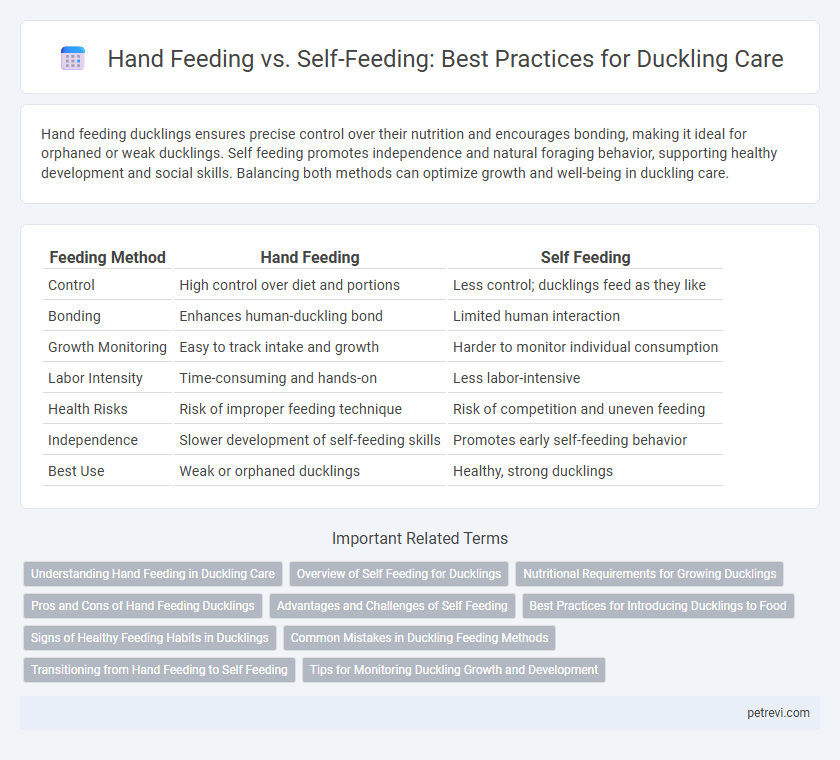Hand feeding ducklings ensures precise control over their nutrition and encourages bonding, making it ideal for orphaned or weak ducklings. Self feeding promotes independence and natural foraging behavior, supporting healthy development and social skills. Balancing both methods can optimize growth and well-being in duckling care.
Table of Comparison
| Feeding Method | Hand Feeding | Self Feeding |
|---|---|---|
| Control | High control over diet and portions | Less control; ducklings feed as they like |
| Bonding | Enhances human-duckling bond | Limited human interaction |
| Growth Monitoring | Easy to track intake and growth | Harder to monitor individual consumption |
| Labor Intensity | Time-consuming and hands-on | Less labor-intensive |
| Health Risks | Risk of improper feeding technique | Risk of competition and uneven feeding |
| Independence | Slower development of self-feeding skills | Promotes early self-feeding behavior |
| Best Use | Weak or orphaned ducklings | Healthy, strong ducklings |
Understanding Hand Feeding in Duckling Care
Hand feeding ducklings involves providing precise portions of formulated feed directly to ensure optimal nutrition and growth during their early developmental stages. This method helps monitor food intake, prevents competition among siblings, and supports weaker ducklings that might struggle to eat independently. Understanding the balance between hand feeding and encouraging self-feeding is crucial to promote healthy digestion and natural foraging behaviors in ducklings.
Overview of Self Feeding for Ducklings
Self feeding encourages ducklings to develop natural foraging behaviors, enhancing their independence and motor skills. Providing easy access to clean water and age-appropriate starter feed supports their nutritional needs while promoting healthy growth. Observing their ability to feed themselves allows caretakers to adjust diet and environment to optimize wellbeing and prevent over-reliance on hand feeding.
Nutritional Requirements for Growing Ducklings
Hand feeding allows precise control over the nutritional intake of ducklings, ensuring they receive essential vitamins, proteins, and minerals critical for rapid growth and immune system development. Self feeding enables ducklings to choose diverse natural food sources like insects and plants, which contribute to balanced nutrition and stimulate natural foraging behaviors. Properly balanced diets containing niacin, protein, and calcium are vital during early development stages to prevent deficiencies and support healthy bone and feather growth.
Pros and Cons of Hand Feeding Ducklings
Hand feeding ducklings ensures precise nutrition control and strengthens the bond between caregiver and duckling, promoting easier domestication and health monitoring. However, it demands significant time and effort, risks dependency that may impair natural foraging skills, and increases the chance of illness transmission if hygiene is inadequate. Balancing these factors is crucial for optimal duckling development and long-term survival.
Advantages and Challenges of Self Feeding
Self-feeding encourages ducklings to develop natural foraging behaviors and independence, which enhances their motor skills and reduces reliance on human caregivers. Challenges include ensuring the availability of appropriate, nutritionally balanced feed that is easy for ducklings to access and digest without assistance. Monitoring is necessary to prevent malnutrition and to support weaker ducklings who may struggle with self-feeding initially.
Best Practices for Introducing Ducklings to Food
Hand feeding ducklings ensures controlled nutrition and helps monitor their intake during early development, reducing risks of malnutrition. Self feeding encourages natural foraging behavior and independence, promoting healthy growth and motor skills. Introducing a balanced diet with finely chopped greens and starter pellets supports optimal digestion and strengthens immune response.
Signs of Healthy Feeding Habits in Ducklings
Healthy ducklings exhibit consistent eagerness during feeding times, whether hand-fed or self-feeding, indicating proper nourishment and growth. Bright eyes, steady weight gain, and active behavior after meals are key signs of successful feeding habits. Observing smooth feather development and regular droppings further confirms their well-being and effective digestion.
Common Mistakes in Duckling Feeding Methods
Hand feeding ducklings often leads to overfeeding and improper diet balance, causing malnutrition or obesity. Self-feeding encourages natural foraging behavior but risks insufficient nutrition if food is not easily accessible or appropriate. Common mistakes include offering inappropriate food textures, neglecting water availability, and failing to monitor consumption quantities, all of which can hamper healthy growth.
Transitioning from Hand Feeding to Self Feeding
Transitioning ducklings from hand feeding to self feeding requires introducing them gradually to solid foods like starter pellets and finely chopped greens while ensuring fresh water is always available. Offering food in shallow dishes encourages independent eating, reducing reliance on hand feeding and promoting natural foraging behaviors. Monitoring their growth and health during this phase ensures a smooth shift to full self-sufficiency without nutritional deficiencies or stress.
Tips for Monitoring Duckling Growth and Development
Monitor duckling weight daily using a precision scale to ensure steady growth within the 5-7% body weight gain per day standard. Observe feeding behavior closely, noting active pecking and drinking as indicators of proper nutrition when transitioning from hand feeding to self feeding. Maintain a clean environment and check for leg strength and alertness, which are key developmental milestones signaling healthy progress.
Hand Feeding vs Self Feeding for Duckling care Infographic

 petrevi.com
petrevi.com